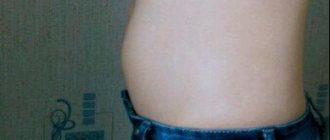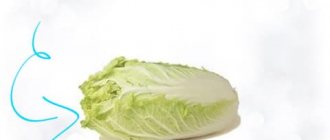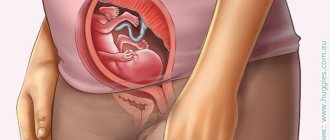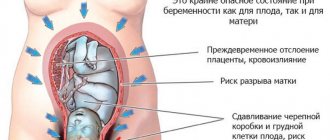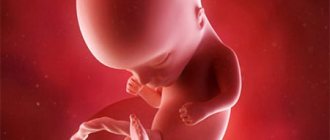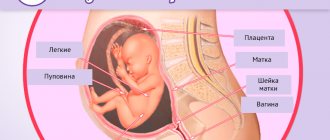- 20th week of pregnancy - how many months?
- Stomach
- Uterus
- Ultrasound
- Fetus
- Feel
- Pain
- Discharge
- Weight
- Nutrition
- Sex
- Analyzes
- Frozen pregnancy
20th week of pregnancy how many months?
The 20th week of pregnancy becomes a “milestone” for the entire period of bearing a child. After all, the 20th week of pregnancy falls at the end of the fifth month: if childbirth occurs at 40 weeks, then the 20th week of pregnancy will be exactly “half of the journey.”
Belly at 20 weeks of pregnancy
At the 20th week of pregnancy, it is no longer possible to hide the belly: it rises more and more, becoming significantly rounded. At the same time, the waist “blurs” and disappears. Nowadays, the use of special products that prevent the appearance of stretch marks on the abdomen due to its enlargement and stretching of the skin is becoming more relevant. All kinds of gels and creams are now sold in abundance in pharmacies and specialty stores; you need to use them regularly - 1-2 times a day, rubbing with massage movements into the stomach in the 20th week of pregnancy, as well as into the hips and chest area. A complete “replacement” for special products can be ordinary vegetable oil - olive or almond.
Uterus
The growth of the abdomen occurs as the uterus enlarges at 20 weeks of pregnancy. At this stage, the uterus is already approximately at the level of the navel - the bottom of the uterus is located 11-12 cm above the womb. At 20 weeks of pregnancy, the uterus can sometimes already contract: such contractions are called false contractions, and they do not pose any threat to the fetus.
Nutrition at 20 weeks of pregnancy
To ensure proper nutrition during the 20th week of pregnancy and the body is saturated with useful substances, you should eat only high-quality and natural products. Meals should be frequent, but you should eat little. You can snack on sliced fruit or vegetables, or drink a glass of fresh juice.
The menu must include lean meat, milk, cereals, fermented milk products, fish and bran bread. Food should be steamed, boiled, baked or stewed. Smoked and fried foods should be excluded from the diet. Chocolate can be consumed in small quantities, just like cakes.
Alcohol is completely excluded at the 20th week of pregnancy. It is necessary to give up strong drinks even at the stage of planning a child.
Ultrasound
Ultrasound examination at this time is usually carried out as part of the second screening. An ultrasound at 20 weeks of pregnancy may be needed to assess the progress of pregnancy, determine the sex of the child, the likelihood of malformations and chromosomal abnormalities. Also, an ultrasound at the 20th week of pregnancy allows you to determine whether the size of the fetus corresponds to the gestational age, whether the condition of the amniotic fluid and placenta is normal.
When performing an ultrasound at the 20th week of pregnancy, the internal organs of the baby are also examined: kidneys, stomach, bladder and gall bladder, liver, lungs, intestines. The baby's heart is also subject to careful examination - if any discrepancy is detected, a specialized ultrasound examination of the heart will be required. Unfortunately, heart defects are one of the most common fetal malformations today.
In addition to the fact that ultrasound will help assess whether the baby’s development is normal, an ultrasound at the 20th week of pregnancy will also show: the baby is actively growing and developing in the womb. And yet, it doesn’t get bored at all, because its size still allows it to move freely in the mother’s tummy, which the baby actively uses, turning over and tumbling.
Ultrasound at 20 weeks of pregnancy
Ultrasound examination of the fetus is carried out as part of a prenatal diagnostic complex. An ultrasound specialist can accurately determine the sex of your baby, moreover, you can see for yourself!
In boys, the testicles descend from the abdominal cavity into the scrotum.
The most informative is 3d 4d ultrasound, thanks to which you can view the back, facial structures, fetal head, and so on.
When conducting a standard ultrasound examination, the main dimensions of the fetus are measured, necessary for diagnosing its normal development.
Fetal dimensions at the twentieth week of pregnancy:
- biparietal size: 43 – 53 mm.
- fronto-occipital: 56 – 68 mm.
- head circumference: 154 – 186 mm.
- abdominal circumference: 124 – 164 mm.
- humerus: 26 – 34 mm.
- forearm: 22 – 29 mm.
- femur: 29 – 37 mm.
- shin: 26 – 34 mm.
During an ultrasound examination at the 20th week of pregnancy, the fetal organs must be examined. His kidneys are visible, dilation of the pelvis is excluded, the stomach, bladder, gall bladder, intestines, heart, and lungs are visible.
An ultrasound examination of the heart determines its position, the symmetry of the heart chambers, the integrity of the septa, the great vessels and their outlets. If there are discrepancies, the expectant mother is sent for a specialized ultrasound examination of the fetal heart, this is necessary to exclude heart defects.
Also, at the twentieth week of pregnancy, an ultrasound examination determines the presence of segmental contractions of the muscular layer of the uterus.
Fetus at 20 weeks of gestation
After all, the baby is now fully formed, his growth continues steadily, and the functioning of his organs and systems is improved. The baby’s nervous system, respiratory, digestive and hematopoietic organs are formed and fully functioning. The little heart beats audibly: you can listen to the rhythm of the baby’s heart with the help of an ordinary stethoscope.
The baby’s arms and legs have also acquired their final shape, marigolds are growing on the fingers, and the first hairs – lanugo – are appearing on the head. Also, fluff forms where in the future the baby will have eyebrows and eyelashes.
The fetus at 20 weeks is already fully aware of sounds, so the mother needs to beware of sudden noises. The baby also reacts to light - even though his eyes are still closed, rays of light penetrate under the eyelids, which begin to open slightly.
At the same time that the baby’s skin thickens, the sebaceous glands produce a special “native lubricant” - for now it protects the baby from the effects of a liquid environment, and in the future it will help the fetus slide more easily through the birth canal and facilitate its birth.
If we talk about the “parameters” of the baby, then the fetus at the 20th week of pregnancy reaches 25 cm in length and weighs about 300-340 g. Its size and weight not least explain the fact that the mother already fully feels the activity of the baby.
Development and size of the fetus at 20 weeks of gestation
What happens to mother and baby at 20 weeks of pregnancy? The weight of the child (fetus) at the 20th week of pregnancy is 270-350 grams, and the size of the fetus is 24-26 cm. Until this time, due to the legs being in a bent position, measurements were taken only to the tailbone, but now adult standards are applicable to the fetus - height from head to toe.
Within a few weeks the baby will theoretically become viable. The fetus has almost all systems and organs formed, but it will take more time for them to be fully ready to work outside the womb.
The child can already distinguish sounds and light, he can turn his head and suck his finger. He mostly sleeps, but there are also periods of wakefulness. The baby's skin becomes denser, and fatty tissue appears underneath. Only there is still no fat on the face, so it remains wrinkled.
The 20th week of pregnancy is also significant because at this time the baby opens his eyes for the first time, which have not only eyelids, but also eyelashes. He develops a reflex blink. Fetal movements at the 20th week of pregnancy are already clearly felt by the expectant mother. At this time, it is important to communicate with the baby; you can sing songs to him.
By the 20th week of pregnancy, many babies are in the correct intrauterine position - upside down. If this has not happened yet, then do not worry, since there is still plenty of time for a coup, and this may happen more than once.
Feel
The baby’s first movements justifiably make the mother extremely happy: now she fully feels that a new life is growing and improving inside her. Which from time to time makes itself felt with slight jolts and movements - the baby hiccups, pushes away from the wall in the uterus and swims to the opposite one, jumps in response to a sharp sound or excitement of the mother. If at first the movements of the fetus are barely noticeable, then over time they become more and more obvious. However, you should pay attention to the nature and intensity of the fetal movements: if its movements are felt excessively often, it is quite possible that in this way the baby declares a lack of oxygen.
Other – less “pleasant” – sensations become at the 20th week of pregnancy, associated with an ever-growing uterus and increasing pressure from the internal organs. It is the change in the configuration “inside” a woman that explains the appearance of heartburn, constipation, poor urine flow, and shortness of breath. However, all these unpleasant phenomena will pass in the near future - when the woman becomes a happy mother.
Sex at 20 weeks pregnant
If the gynecologist does not prohibit sex at 20 weeks of pregnancy, then intimate life should not stop. However, when making love, you should choose comfortable positions in which the woman will not feel discomfort.
A pregnant woman should derive pleasure from intimacy, which results in the production of serotonin, which has a positive effect on the development of the baby’s central nervous system.
Sex should be avoided during multiple pregnancies, placenta previa and the threat of miscarriage. In other cases, intimate life is beneficial for both mother and baby.

Pain
Most often, expectant mothers during this period complain of pain in the 20th week of pregnancy, appearing in the lower back and back. This is a consequence of a significant load on the joints and ligaments, back muscles, due to a shift in the center of gravity. To prevent back and lower back pain, there are special exercises that help “unload” the spine. But, at the same time, it is also necessary to follow basic rules that will help, if not avoid, then significantly reduce pain in the lower back and back during the 20th week of pregnancy. These rules involve maintaining correct posture, avoiding high heels and using all possible measures that will make it possible not to strain your back.
20 week pregnancy video
20 week pregnancy photo
Another fairly common problem among pregnant women is the appearance of leg cramps. The pain in the 20th week of pregnancy can be so noticeable that it “brings” the woman to tears. Cramps are a consequence of constantly increasing weight and increasing stress on the legs. To minimize the likelihood of cramps, you should regularly rest your legs, resort to a relaxing massage of your calves and feet, and stretch your legs on the bed more often.
Pain in the abdomen at 20 weeks of pregnancy is an alarming phenomenon. If your stomach hurts from time to time and not too much, you still need to consult a doctor: to avoid the possibility of increased uterine tone and possible miscarriage for this reason. If the stomach hurts severely, it is necessary to seek specialized help immediately, otherwise tragic consequences and the loss of the child cannot be avoided.
Belly size at 20 weeks
The abdominal circumference at the 20th week of pregnancy is approximately 70-75 cm. The fundus of the uterus is two transverse fingers below the navel.
To “unload” the spine, doctors recommend performing special gymnastics for pregnant women. Water aerobics for pregnant women and fitball exercises have a very good effect. It is worth giving up shoes with heels, maintaining your posture and trying not to put stress on your back. Clothing for pregnant women should also be as comfortable as possible, preferably made from natural fabrics and without straps, elastic bands, etc. squeezing the stomach. Following these recommendations will definitely help if you have back pain during pregnancy.
Discharge at 20 weeks of pregnancy
After all, it is abdominal pain (sharp or nagging, but long-lasting), and even accompanied by bloody or brown discharge, that becomes a harbinger of the threat of premature termination of pregnancy. Also, spotting, accompanied by pain in the lower abdomen, may be a symptom of abruption or placenta previa - in any case, consultation with a gynecologist is necessary. If spotting at the 20th week of pregnancy is not accompanied by painful sensations, but occurs more and more after sexual intercourse or a gynecological examination, erosion of the cervix most likely occurs.
Normally, discharge at the 20th week of pregnancy is light in color - grayish or with a milky tint. At the same time, they have a sour smell and a homogeneous consistency. The appearance of green or yellow discharge, cheesy, mixed with lumps of mucus, indicates an ongoing infection. Usually, infection is also accompanied by a feeling of burning and itching in the vaginal area, and in this case you should not hesitate to contact a specialist. After examination, the doctor will prescribe appropriate treatment to avoid the spread of infection and not “start” the disease.
Weight
Your weight during the 20th week of pregnancy must be monitored responsibly: ideally, a woman’s weight should not exceed 15-16 kg until the end of pregnancy, otherwise childbirth will be much more difficult. Considering that the weight at the 20th week of pregnancy can already increase to 3-6 kg (and the “ideal” increase is considered to be just 3 kg), the issue of weight needs to be given maximum attention. From this week, you need to do everything possible to ensure that your weekly weight gain is about 500 g, therefore, it will not be amiss to develop a diet that should be followed throughout pregnancy.
Lifestyle at 20 weeks of pregnancy: tips
The main thing depends on the lifestyle the expectant mother leads: how the birth will go and whether the newborn baby will be healthy.
Restrictions
When you are 20 weeks pregnant, there are many prohibitions that should be followed:
Bad habits
From the moment of conception, or from the time of planning fertilization, you should give up bad habits that have a detrimental effect on the fetus. Smoking and drinking alcohol are dangerous in the embryonic, perinatal and postpartum periods of a baby’s development.
Overheating
Overheating often leads to premature birth. To avoid an accident, you should not visit saunas and steam baths. Prolonged exposure to the sun is also dangerous for the expectant mother. Sunbathing is possible only in a shaded place in the morning.

Body positions when resting
The threat of premature birth may arise due to lying on the stomach, prolonged rest on the back or right side. When sitting cross-legged, blood flow is disrupted, which leads to oxygen starvation, which can result in miscarriage.
Physical exercise
Sudden movements, bending, and heavy lifting are contraindicated at 20 weeks of pregnancy.
These actions can provoke uterine hypertonicity, which can lead to miscarriages. High-heeled shoes cause increased stress on the spine and lower limbs, which will have a negative impact in the future.

Chemical substances
It is not recommended to use household chemicals during cleaning. Substances containing toxins are often used in cosmetics and hygiene products. Preference should be given to natural products.
Extreme sports and travel
At the 20th week of pregnancy, extreme sports are prohibited and are replaced by calm recreational activities. Travel is allowed, because there is a lot of time left before the birth. There is no ban on flying on an airplane. When traveling by road, you must stop at four-hour intervals to eat. After 2 hours, you must get out of the car to stretch your legs. A pregnant woman can drive for no more than an hour.
The following are strictly prohibited:
- Climbing to a height of more than 1 km above sea level.
- Diving.
- Parachuting.
What is good for mother and baby
The 20th week of pregnancy requires continued proper nutrition and a healthy lifestyle. Swimming, water aerobics, and Nordic walking are allowed. Walking at a calm pace in green areas is recommended.
Communication with friends and relatives, going to museums, visiting theaters is beneficial. It is advisable to devote your free time to your favorite activities.
Sex
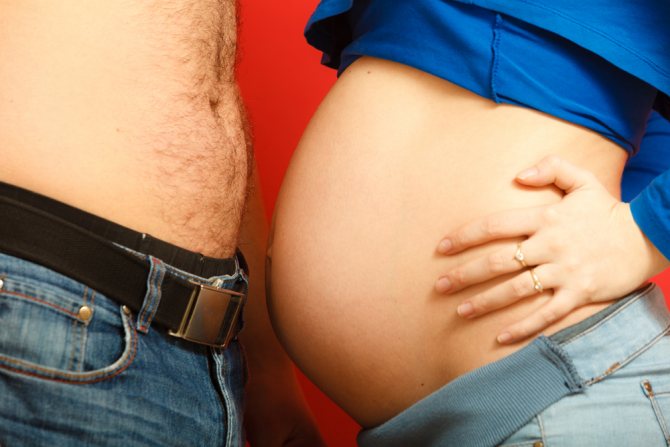
If there is no doctor's prohibition, continuing intimate life will have a positive effect on the course of pregnancy. In this case, preference should be given to comfortable postures. If discomfort is felt, change position or complete sexual intercourse. Sex should bring pleasure to the pregnant woman, which produces a happiness hormone that has a positive effect on the baby’s emotional development.
Nutrition
Recommendations regarding nutrition at 20 weeks of pregnancy remain the same: nutrition should be balanced and healthy, food should be as natural and healthy as possible. Considering that in the second trimester (when toxicosis and associated unpleasant sensations are a thing of the past), a pregnant woman’s appetite is excellent, it is advisable to build a diet in such a way as to extract as much as possible all the useful and nutritious substances from foods and at the same time not feel hungry.
To do this, it is advisable to eat often throughout the day, but little by little, have a full breakfast and lunch, and prefer light food for dinner. A pregnant woman's table must include (lean) meat, vegetables and fruits in large quantities, dairy and fermented milk products, and cereals.
Experts also advise to listen sensitively to desires to “eat something like that.” For example, the desire for chocolate may be related to the body's need for carbohydrates. But the carbohydrates extracted from chocolate and other sweets are completely unhealthy: these carbohydrates are “empty”, and besides, they raise the level of glucose in the body. Therefore, it is better to “get” the necessary carbohydrates from bread with bran, fruits, and cereals. Again, porridge will become a source of B vitamins, and buckwheat will also provide iron, phosphorus can be obtained from fish, vitamin A from carrots, folic acid from broccoli.
Food is best prepared by boiling, baking or stewing foods. It’s better to forget about smoking and frying for a while - it’s not healthy at all, and it also provokes heartburn. In addition, you should significantly limit the use of salt when cooking: salt retains water in the body and causes the formation of edema, which significantly overshadows the happy time of pregnancy.
Sex
But sex at 20 weeks of pregnancy may well replace the pleasure you get from an extra half a bar of chocolate. Intimate life is not at all prohibited, unless, of course, there are any contraindications from a doctor. But when practicing sex at 20 weeks of pregnancy, you should choose positions that eliminate pressure on the mother’s belly and not be too “overzealous” with intensity. And you should pay attention to sensations during sexual intercourse: any discomfort or feeling that the uterus is “shrinking” should be a reason for mandatory and, if possible, consultation with a specialist as soon as possible.
Leakage of amniotic fluid
Amniotic fluid is necessary for the baby for normal development and protection from external irritants. Amniotic fluid has a unique composition and has bactericidal properties. It often happens that mothers are diagnosed with amniotic fluid leakage. Why is this condition dangerous at 20 weeks of pregnancy?

At this time, the normal volume of water should be about 200-300 ml. Polyhydramnios or oligohydramnios is diagnosed when there are significant deviations from these indicators.
Leakage of amniotic fluid, even if it is just a few drops, indicates depressurization of the placenta. Consequently, various pathogens can reach the child. At the same time, it is quite difficult to detect an infection in a baby. This leads to dangerous consequences, including miscarriage.
Causes
Among the causes of this condition, experts most often name cervical pathologies. If the cervix is short or dilated prematurely, this entails favorable conditions for damage to the amniotic sac. Another provoking factor for water leakage is mechanical damage to the bladder during various medical procedures.
Symptoms and treatment
You can suspect leakage of amniotic fluid based on atypical discharge in the form of watery spots on your underwear. You can test yourself at home with a simple test. To do this, you need to take a shower, thoroughly wash your genitals and lie down on a dry, clean bed. If after 15 minutes you notice even a small watery spot on the sheets, you should immediately consult a doctor.
You might be interested in: Signs of an ectopic pregnancy
With the pathology in question, doctors’ actions are usually aimed at preserving the baby’s life. The woman is prescribed regular examinations by a gynecologist and the necessary tests. During the examination, the fetal heartbeat, the quantity and quality of amniotic fluid in dynamics are assessed, and the mother’s well-being is necessarily taken into account.
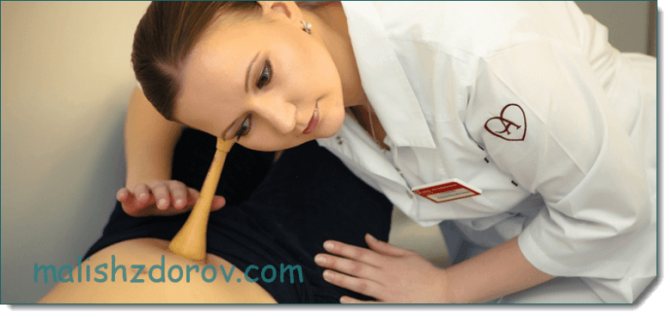
Prevention of this dangerous condition consists of planning pregnancy, timely treatment of diseases of the reproductive system and regular examination at the antenatal clinic when conception occurs.
Tests at 20 weeks of pregnancy
If before the 20th week of pregnancy, visiting a doctor and mandatory tests were supposed to be done once a month, then, starting from the 20th week, specialist supervision is needed twice a month. Tests at the 20th week of pregnancy (in addition to ultrasound) may be needed to examine blood, urine, and to assess uterine enlargement.
A blood test allows you to monitor mommy’s blood sugar levels and determine the presence of anemia in time. A urine test will tell you about the functioning of the kidneys, as well as possible hidden inflammatory processes. Ultrasound, as discussed above, in itself becomes a very informative research method, which can sometimes be supplemented and “strengthened” by a biochemical blood test - the so-called “triple test”. This analysis is done to assess the level of the hormones hCG, estriol and alpha-fetoprotein in the mother’s blood: deviations from the required standards indicate a high risk of having a baby with developmental defects or chromosomal abnormalities.
ARVI at 20 weeks of pregnancy
ARVI at week 20 is no longer as dangerous for the child as it was in the first trimester, because the fetus is reliably protected by the placenta. However, due to a cold, fetoplacental insufficiency can occur, as a result of which the baby does not receive enough oxygen, which leads to developmental delays and increases the risk of having a baby prematurely.
If a cold does start, it should be treated immediately, since if it starts, it will affect the endocrine system, which will have a negative impact on the formation of bone tissue and the reproductive system in the fetus, if the woman is carrying a girl. In case of a cold, the expectant mother will be given a gentle treatment, which will consist of taking a minimum number of tablets and a large number of safe traditional medicine.
Also, a pregnant woman will be required to remain in bed, drink a lot of tea with raspberries and lemon, gargle and rinse her nose with saline solution and infusions of medicinal herbs.
If your body temperature is elevated, you should take antipyretic medications prescribed by your doctor. If the temperature has not reached 38 degrees, you need to allow the body to fight the disease on its own.
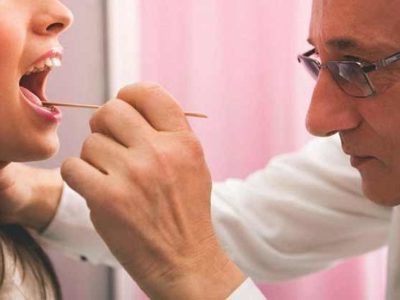
Frozen pregnancy
Although miscarriage is more common in the early stages, miscarriage at 20 weeks also happens quite often. The fetus can stop developing and die for many reasons: endocrine disorders, exposure to negative factors, and failure of progesterone production.
But if diagnosing a non-developing pregnancy in the early stages is possible only with the participation of a doctor, then a frozen pregnancy of 20 weeks can be “felt” by a woman personally. Reason for suspicion may be the cessation of abdominal enlargement, as well as the absence of fetal movements. However, it should be borne in mind that the baby does not have to move all the time: the baby also has its own sleeping and waking patterns, therefore, the absence of movements for some time can be explained by the fact that the baby is simply sleeping.
Usually, a frozen pregnancy of 20 weeks is diagnosed without difficulty: using ultrasound, as well as in the absence of a fetal heartbeat. And in this case, doctors will act immediately: the uterus must be freed from the dead fetus, which contributes to the development of infection. After curettage, the woman is prescribed an additional examination, which may help establish the reason that led to the fading of the pregnancy. You will also need antibacterial therapy and a fairly long recovery time - after the pregnancy has died, planning the next pregnancy is not recommended earlier than six months to a year later.
Baby development at 20 weeks
It is interesting to know that some peoples associate the twentieth week of pregnancy with the appearance of a soul in the child. Be that as it may, the baby can already hear your voice, and mother’s heartbeat is the best sedative for the little man. The baby's size increases every day and at this stage his height reaches 14-16 cm and his weight is about 260 g.
Do you want to know what happened to the baby at 19 weeks? Then our article is just for you.
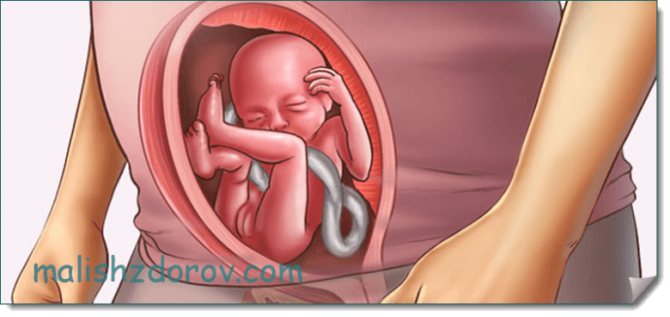
What changes happen to the baby at week 20:
- You can now hear the beating of a tiny heart not only with the help of ultrasound. Mommy can listen to the heartbeat herself using a regular stethoscope.
- The first hairs begin to appear on the baby's head.
- Nail plates are visible on the fingers and toes.
- The formation of permanent teeth continues.
- The child's epidermis becomes denser. Now it consists of four layers.
- The baby continues to sleep a lot, but can already distinguish between day and night. During the waking period, he tumbles, turns, plays with his arms, legs, and umbilical cord.
- The skin becomes lighter, more attractive, but still has many wrinkles.
- At the 20th week of pregnancy, the baby’s immune defense completes its formation. Now it can resist various pathogens.
- The formation of grooves and convolutions ends on the surface of the brain.
At this stage, the baby's eyes open slightly. He clearly reacts to bright light, which manifests itself in the form of grimaces and squinting.
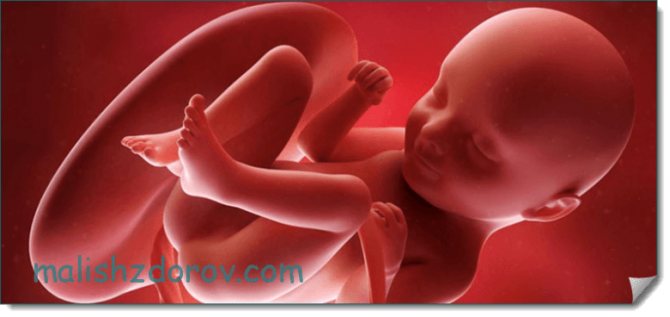
The toddler is becoming more and more like a newborn, his body is becoming proportional. If you are already wondering how your baby will develop after birth, read this article.
Difficulties at week 20
The most dangerous period is considered to be the first trimester of pregnancy. In the first months of carrying a baby, women most often experience miscarriage, fetal death and other pathologies. In the second trimester, the risks decrease somewhat, but dangers continue to lurk for mother and baby. Read more about early pregnancy here.
Low placentation
A common diagnosis in women expecting a child is low placental capacity. The placenta is an organ necessary for the normal development of the fetus in the womb, providing it with all the necessary substances and oxygen. It is normal if the baby's place is attached at least 6-7 cm above the uterine os.
You might be interested in: Pregnancy after a frozen pregnancy
If the placenta is low, this can lead to abruption and premature birth. This attachment often occurs for the following reasons:
- previous miscarriages or abortions;
- trauma to the endometrium of the uterus;
- inflammatory diseases of the reproductive organ;
- congenital or acquired pathologies of the reproductive system in a pregnant woman.
Often the reasons for low placentation remain unclear.
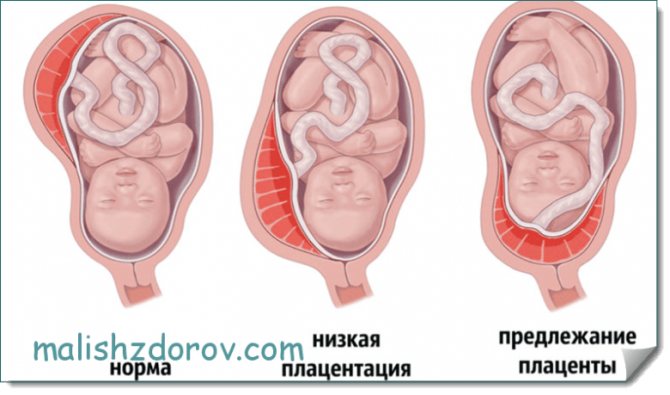
It is impossible to raise the placenta on your own, since there is no drug treatment for the pathology in question. A woman who has been diagnosed with a low placenta should be under close medical supervision, undergo ultrasound examinations more often and undergo prescribed tests. As pregnancy progresses and the uterus increases in size, the baby’s place “migrates” and rises closer to the bottom of the reproductive organ, that is, further from the exit. To select the type of delivery, the girl is prescribed an ultrasound in the later stages.
What to do as a mom:
- refuse to lift any heavy objects;
- exclude sports;
- Sex is strictly contraindicated for this diagnosis;
- when resting, it is recommended to place a pillow under your feet;
- Long trips should be minimized;
- You should immediately consult a doctor if bloody discharge or cramped pain occurs.
And, of course, we must not forget about a positive attitude. In most cases, low or marginal placentation does not interfere with natural childbirth. If contractions are not intense, doctors may use amniotomy, an artificial opening of the membranes. Careful medical monitoring and attentive attitude to your body helps to give birth to a healthy baby with a low placenta.
Hypertonicity of the uterus
Increased uterine tone at 20 weeks of pregnancy is a rather alarming sign.
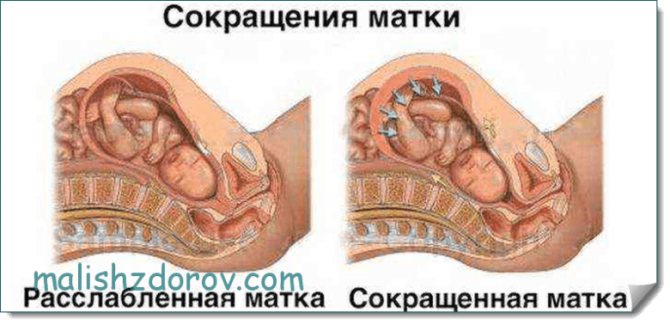
At the same time, mommy gets the feeling that the uterus seems to be turning to stone and hurting. The main reasons that provoke this condition include:
- intense physical activity;
- housework;
- lifting weights;
- performing sports exercises;
- long trips;
- infection with TORCH infections (most often hypertonicity is caused by toxoplasmosis and cytomegalovirus);
- stress and emotional overload of a pregnant woman.
All these conditions cause involuntary contraction of the muscle fibers of the uterus, which negatively affects the condition of the fetus and can even lead to miscarriage.
Can this condition be treated? To eliminate uterine tone, you need to relax. This will help relieve muscle tension in the organ. This result can be achieved only with complete moral and physical peace. If mommy feels another attack, experts recommend lying down, breathing deeply, and thinking about good things.
In severe situations, when due to hypertension there is a threat of miscarriage, the girl requires drug treatment. Under no circumstances should you select medications yourself. This can be very harmful to mother and baby. Only a doctor should prescribe medications. Often, the woman is given various sedatives and sedatives. Magne B6 tablets are popular. They are able to normalize metabolic processes in the body, thereby increasing the resistance of the nervous system to stress.
Fetal presentation at 20 weeks
Throughout pregnancy, the baby actively moves and changes its position several times in the womb. By week 35, there is very little space in the uterus, so the baby, as a rule, occupies a constant position. It is very important here that the presentation of the fetus is correct, that is, head down. This ensures the most comfortable birth. Sometimes it happens that a woman is diagnosed with a pelvic (breech) presentation of the child. This condition occurs in 5% of all mothers.
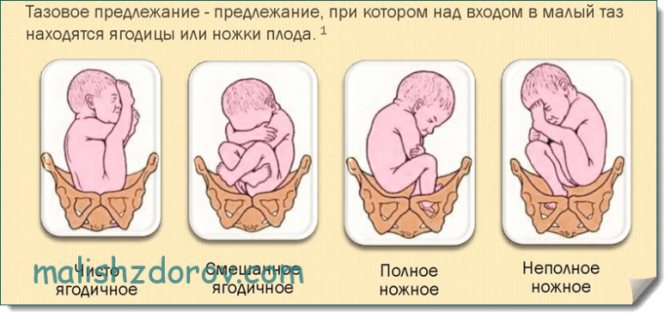
Pelvic proposal is a condition in which the baby is positioned with the buttocks down. Sometimes one or both legs are directed towards the exit of the uterus. In this situation we are talking about a mixed or leg position of the fetus. In medical practice, this condition is classified as a pathology. With the breech position of the fetus, the prognosis is more favorable than with the foot position.
Why does the baby take this position in the womb? The exact causes of this condition are unknown. Scientists suggest that the likely causes include the following:
- congenital or acquired pathologies of the reproductive organs in a pregnant woman at 20 weeks;
- previous miscarriages or abortions;
- frequent childbirth;
- chromosomal pathologies in a child;
- serious diseases of the central nervous system in the baby;
- moderate or severe oligohydramnios, polyhydramnios;
- umbilical cord entanglement;
- twins (often one of the babies turns bottom down).
The presence of these provoking factors does not guarantee the development of breech presentation, but they significantly increase the risk of this pathology.
At 20 weeks of pregnancy, the baby can still change its position in the tummy. Reviews from many girls indicate the good effectiveness of special gymnastics. You can watch these exercises in the video provided.
Before performing gymnastics, consultation with a specialist should be mandatory.
Short cervix
Normally, the length of a pregnant woman’s cervix should be up to 4 cm, but it is often shortened and soft. This diagnosis is indicated if its length is less than 2 cm. Shortening often indicates istic-cervical insufficiency. The growing fetus puts pressure on the uterine os, which entails the threat of termination of pregnancy. During the birth process, a short cervix often causes rapid labor and injuries to the uterus and vagina in a woman.
The reasons for this condition are not completely clear. It is believed that the pathology is caused by congenital anomalies of the reproductive organ, and is also a consequence of mechanical damage to the uterus during induced abortions and other medical procedures.
Treatment consists of following medical recommendations, including the following:
- complete moral and physical peace;
- refusal of intimacy;
- avoiding heavy lifting;
- regular visits to antenatal clinic;
- taking hormonal medications if necessary.
If the threat of miscarriage develops, the patient may need a procedure such as cervical cerclage. The procedure involves temporarily placing sutures in the area of the uterine pharynx. Before birth, the sutures are removed. The operation is performed under anesthesia.
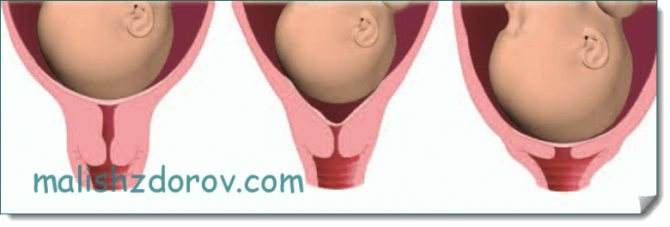
Another method is wearing a gynecological ring, which maintains the cervix in a stable condition and does not allow it to open prematurely.
Troubled waters
Amniotic fluid is a liquid necessary for the normal development and functioning of the fetus. Normally, they contain various suspensions consisting of skin epithelial cells, hair and the child’s cheese-like lubricant. When foreign bodies enter the amniotic fluid, the amniotic fluid becomes cloudy, which poses a threat to the baby’s life.
Among the reasons for this condition, doctors name infection of the uterus with pathogens and a large amount of original feces. An ultrasound examination and tests of a woman for various infections help to establish a diagnosis.
In late pregnancy, the waters become cloudy due to the natural aging of the placenta. The amount of suspended matter increases when the baby is postterm. Read more about week 39 here.
Gestosis at 20 weeks of pregnancy
Late toxicosis usually develops after the fifth month of pregnancy. This condition is detected a little later, most often at 23-24 weeks. The risk group for this pathology includes mothers with the following conditions:
- physical fatigue, frequent stress;
- girls under 18 and over 35 years old;
- frequent childbirth;
- the presence of chronic infections in the body;
- poor nutrition, bad habits;
- diseases of the reproductive system;
- multiple pregnancy;
- congenital anomalies of the structure of the uterus and ovaries.
You might be interested in: Is it possible to take a bath during pregnancy?
Preeclampsia or late toxicosis has an extremely negative impact on both the well-being of the mother and the condition of the baby.

There are several stages of gestosis:
- The first stage, or dropsy in pregnancy, has a mild course. Manifests itself in the development of edema in the arms and legs. You cannot make a diagnosis based on these signs alone. The woman is obliged to report them to the doctor.
- Nephropathy – involvement of the kidneys in the process. In this case, the swelling is accompanied by surges in blood pressure.
- Preeclampsia is characterized by impaired blood circulation in the central nervous system. In this case, the pregnant woman detects protein in her urine and her blood pressure increases significantly. Often the symptoms of this condition include mental disorders in the mother.
- Eclampsia is a severe course of gestosis, in which there is a threat of severe complications. These include seizures, cerebral edema, stroke and malfunctions of other internal organs. Against the background of eclampsia, oxygen starvation of the fetus, placental abruption and even the death of the child often occur.
Late toxicosis is very dangerous at 20 weeks of pregnancy. Each of the previous stages quickly moves into the next. If gestosis is detected, a woman should be under close medical supervision.
Colds in the second trimester
Colds at the 20th week of pregnancy no longer pose such a strong threat to the baby as in the initial stages of embryo development. Despite this, if you experience high body temperature or other warning signs, you should immediately go to the hospital.
Only a doctor can select the necessary medications. The specialist will prescribe treatment taking into account the severity of the disease and the individual characteristics of the pregnancy. You cannot prescribe or stop medications on your own. This can cause serious complications both in the fetus and in the mother herself.
Is the belly visible at 20 weeks?
The size of the tummy at this stage largely depends on the constitution of the pregnant woman’s body, the position of the baby in the womb, and the weight that you have gained during this period. In plump mothers, the roundness is often hidden under a layer of fat; in thin girls, the tummy is more clearly defined. If your weight gain is very rapid, your belly may already seem quite large. Normally, its height should correspond to the duration of pregnancy, that is, at week 20 it should be 20 cm.
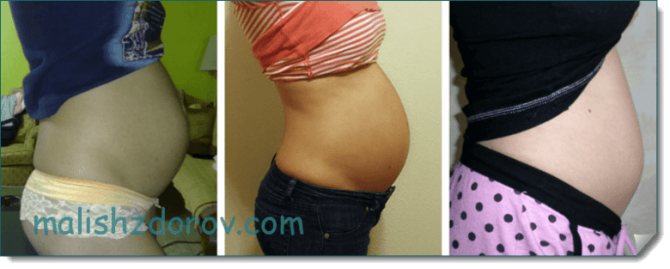
You can see what the bellies of different mothers look like in this photo.
